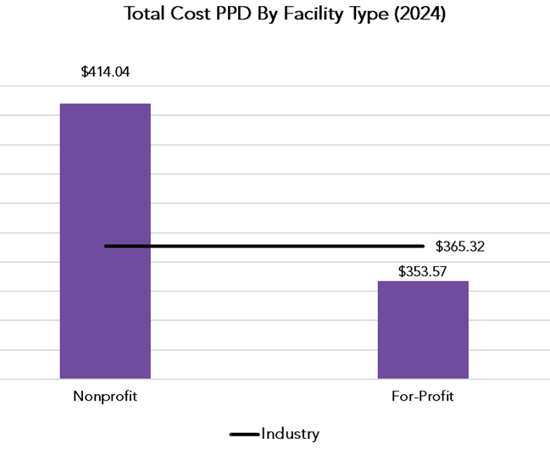After several years of unpredictable cost swings and pandemic-driven volatility, Maryland’s skilled nursing facilities are entering a period of relative stability — but not without continued financial pressure.
In this article, we’ll take a detailed look at how costs have shifted, what’s driving those changes and where facilities are finding relief.
Costs Are Rising, But the Rate of Increase Is Slowing
For the first time since 2020, the cost of caring for residents appears to be leveling out. In 2024, the industry’s total cost per patient day (PPD) rose just 1.08%, from $361.42 to $365.32. This is a modest increase compared to the 3.93% jump in 2023 and well below the national inflation rate of 2.9%.
This moderation signals that facilities are beginning to regain control of their budgets after years of pandemic-related inflation, supply chain disruption and staffing shortages.
Even so, the pre-pandemic trend tells a different story: since 2019, the average total cost per patient day has risen $75.33, a 26% increase. Those higher costs are being driven by many of the same factors facilities have battled for years — personnel, insurance and benefits, and capital improvements, not just the pandemic.

What's Driving Costs Up?
Although pandemic-era expenses like COVID testing and PPE have finally stabilized, other costs are proving stickier.
Among the biggest drivers of 2024’s cost increases:
- Nursing remains the largest expense for facilities — a reflection of continued staffing shortages and reliance on agency nurses
- Capital and property service costs are climbing due to higher interest rates and rising real estate values
- Capital value rental, which includes depreciation, has increased as facilities are beginning to depreciate pandemic driven upgrades like HVAC systems and renovated isolation spaces
- Quality Assessment fees continue to grow, up roughly 402% since 2009
Inflation’s influence is still being felt, even at lower rates. Compared to the 1.24% average in 2020, 2024’s 2.9% inflation has left a lingering mark on operating budgets.
Regional Trends
While costs rose across nearly all regions, Central Maryland continues to be the most expensive area to operate a skilled nursing facility. The region’s total cost per patient day was $372.81 PPD, despite being the only region to report a slight decrease of $3.39 PPD from 2023.
The Baltimore Metro region followed closely at $372.48 PPD, while Western Maryland saw the lowest average cost at $356.95 PPD.
Looking at the five-year trend:
- Western Maryland region facilities have seen the steepest rise in costs — up $62.34 PPD since 2020
- Non-Metro and Baltimore Metro region facilities aren’t far behind, increasing by $55.21 PPD and $42.05 PPD
- Washington Metro facilities, on the other hand, managed to keep costs under tighter control, with a five-year increase of just $27.97 PPD
Why are facilities in the Washington Metro region faring better? The data suggests more efficient resource management and possibly stronger economies of scale in that region.

Facility Size Plays a Role
Smaller facilities continue to shoulder higher per-resident costs, largely due to fixed overhead expenses spread across fewer beds.
In 2024:
- Facilities with 1–44 beds had the highest total cost per patient day at $397.41, despite being exempt from Maryland’s Quality Assessment fee
- Facilities with 100–199 beds fared best at $356.12 PPD, falling below the statewide average
- Facilities with 200+ beds averaged $389.47 PPD, reflecting higher administrative and billing labor costs
In reviewing years’ worth of data from Maryland cost reports, we’ve found that the ideal bed size for a skilled nursing facility continues to hover around 120 beds. Facilities within that range tend to balance staffing, efficiency and care quality most effectively.
From 2020 to 2024, the largest facilities (200+ beds) experienced the largest cost increase — up $52.49 PPD — followed by facilities with 45-99 beds ($45.65 PPD). By contrast, facilities with 1-44 beds saw the smallest increase ($17.96 PPD) in costs.

Nonprofits Still Outspend For-Profit Facilities
When it comes to overall spending, nonprofit facilities continue to outpace their for-profit peers. In 2024:
- Nonprofits averaged $414.04 PPD, roughly $48.72 more than the statewide average
- For-profits averaged $353.57 PPD, about $11.75 below the industry average
This cost disparity reflects nonprofit facilities’ ability to fund enhanced staffing ratios and resident amenities through charitable contributions and endowments. Over the past five years, nonprofits have seen an $88.75 increase in cost per patient day, compared to $74.30 PPD for for-profits.

A Cautious Outlook for 2025 & Beyond
The data points to a cautiously optimistic outlook. Costs are stabilizing, inflation is cooling and many facilities are regaining operational footing. But the financial burden remains heavy — particularly for smaller and nonprofit providers.
Facilities should continue monitoring their cost structures closely, benchmarking against similar providers and planning strategically for potential shifts in Medicaid and Medicare funding.
For a detailed look at how your facility compares to others across Maryland, request your facility’s scorecard from our Healthcare Group.
Want More Data Like This?
Our annual benchmark report for skilled nursing facilities in Maryland includes a breakdown of data in multiple cost areas, broken down by industry, region, facility size and type.
Need Help?
Contact us online or call 800.899.4623.


